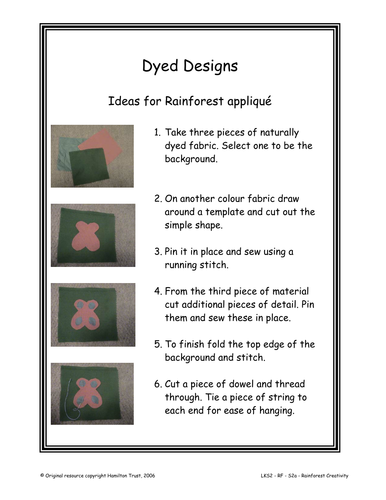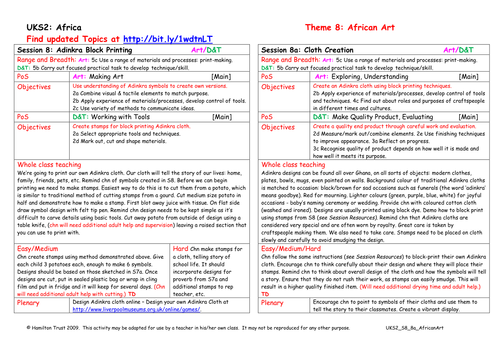
397Uploads
10045k+Views
11646k+Downloads
Art and design

Observational drawing of a favourite toy
Children learn the word ‘texture’. They look carefully at their favourite toy and talk about the feel and appearance. They decide which media they want to use to represent it and do a beautiful drawing! They talk about their work and the work of other people.
Suitable for years 1 and 2.

Notting Hill Carnival
Read Benjamin Zephaniah’s poem The Men from Jamaica are Settling Down. Discuss the treatment that migrants from the Caribbean received from some British people. Explain how this lead to riots and the first Notting Hill Carnival. Children design carnival costume.

Rainforest Pastel Pictures
Using Where the Forest Meets the Sea children study in detail the palette of colours created by the rainforest. Then using pastels and blending techniques children create a pastel rainforest picture.
Suitable for years 3 and 4.

Batik Technique
Introduce children to the techniques of flour resist batik and explore the history of batik in Africa. Children get a chance to practise the methods themselves.

Make a Moving Dogger
Practise cutting and joining skills by making a moving Dogger. This session links to English Plan 2 Stories with familiar settings. Learn how to cut well, make a hole in cardboard and construct moving joins using paper fasteners.

Beautiful Batik
Focus on the beautiful batik found in Mozambique. Explore the visual and tactile elements, including use of colour and pattern.
Children use sketchbooks to copy and explore sections of these designs concentrating on composition and subject matter.

Mask Making
Make a Kple Kple mask using air-dry clay. Based on their research children design and make their own versions of these fascinating African masks.

Appliqué – Cutting & Sewing
In this session children complete their Appliqué by cutting and sewing the pieces of their design before proudly displaying it in the classroom. They take time to reflect on the whole dyeing and designing process and evaluate the finished product.

Adinkra Block Printing
Selecting appropriate tools and techniques chn create potato stamps of their own Adinkra cloth symbols, ready to block print on a cloth.

Australian Rainforest Animals
Children think about the animals that they know come from Australia and then find out if they live in any of its rainforest regions. Children then look at a list of Australian rainforest animals, and print an image from the computer.

Asylum Seekers
Explain that some people come to Britain as asylum seekers or refugees to escape from problems in their home country. Use The Arrival by Shaun Tan to empathise with people coming to Britain. Children draw part of one of short stories from Give me Shelter.

Jungle Jars, Bowls and Pots
In this session children take a look at typical examples of pots created by peoples of the Rainforests. They study the differences in pattern and decoration before creating their own pot from clay and decorating it.

1950s Art
Children look at 1950s sculptures by Barbara Hepworth and Henry Moore and make their own similar model from clay.

Join The Masquerade
Join the masquerade! African masks often form part of a dramatic performance which incorporates dance and music.
Using African music as inspiration children create simple dance steps to show off their masks.

Adinkra Cloth
Moving to West Africa, children explore how history of Asante people has been represented through the craft of block printing Adinkra cloths.
Children use web research to find out about history, techniques and processes involved.

Australian Rainforest Animals 2
In this session children take the image of their Australian Rainforest animal printed in the previous session and use it as a starting point for a pastel picture.

Ndebele Beadwork
Zooming in on South Africa, children are introduced to the incredible beadwork of the Ndebele people of KwaNdebele.
Through web images children explore the history of this craft and investigate its key visual elements.

Meals In The 1950's
Children look at pieces of kitchen equipment and guess which were available in the 1950s. One group make a real chicken meal, whilst the others make a typical 50s dinner from Plasticine, an ICT package or paint/collage materials. All taste the 50s dinner.

Endangered orang-utans (2)
Orang-utans are humans closest relative! Children find out more about the great ape and other great apes like chimps and gorillas, before using sketching and shading techniques to draw Orang-utans for display.

Goli Masks
Narrowing the focus, children discover more about the features of a Goli mask used in all-day festivals of the Baulé peoples.
Children carry out an investigation into stylistic elements of the mask and their meanings and purpose.




















